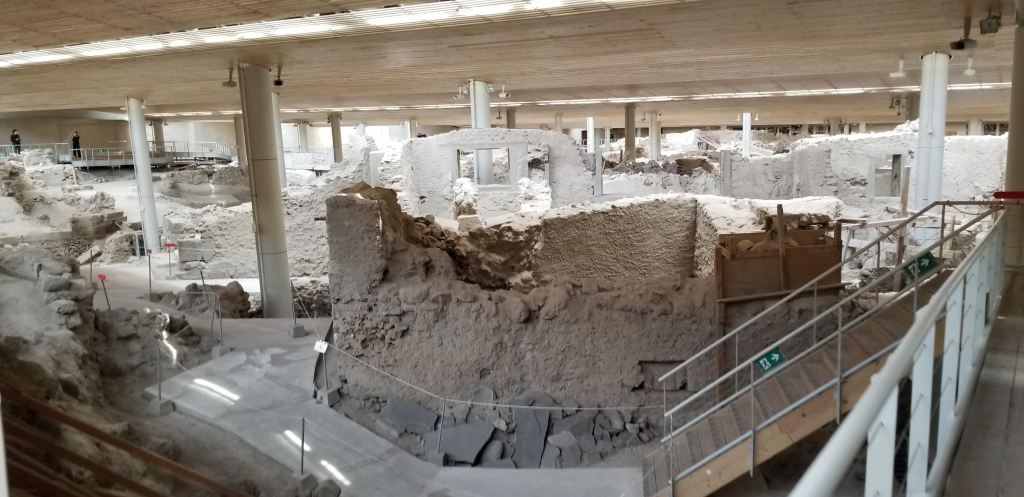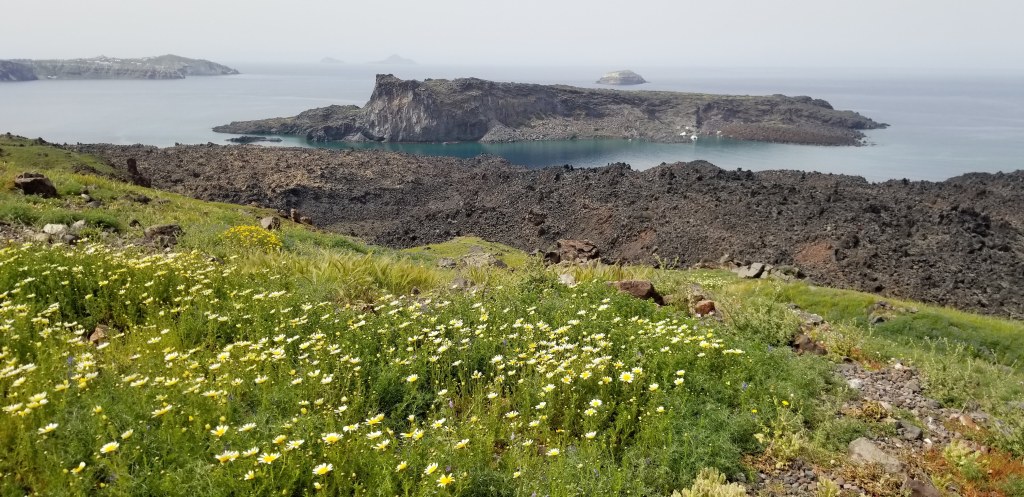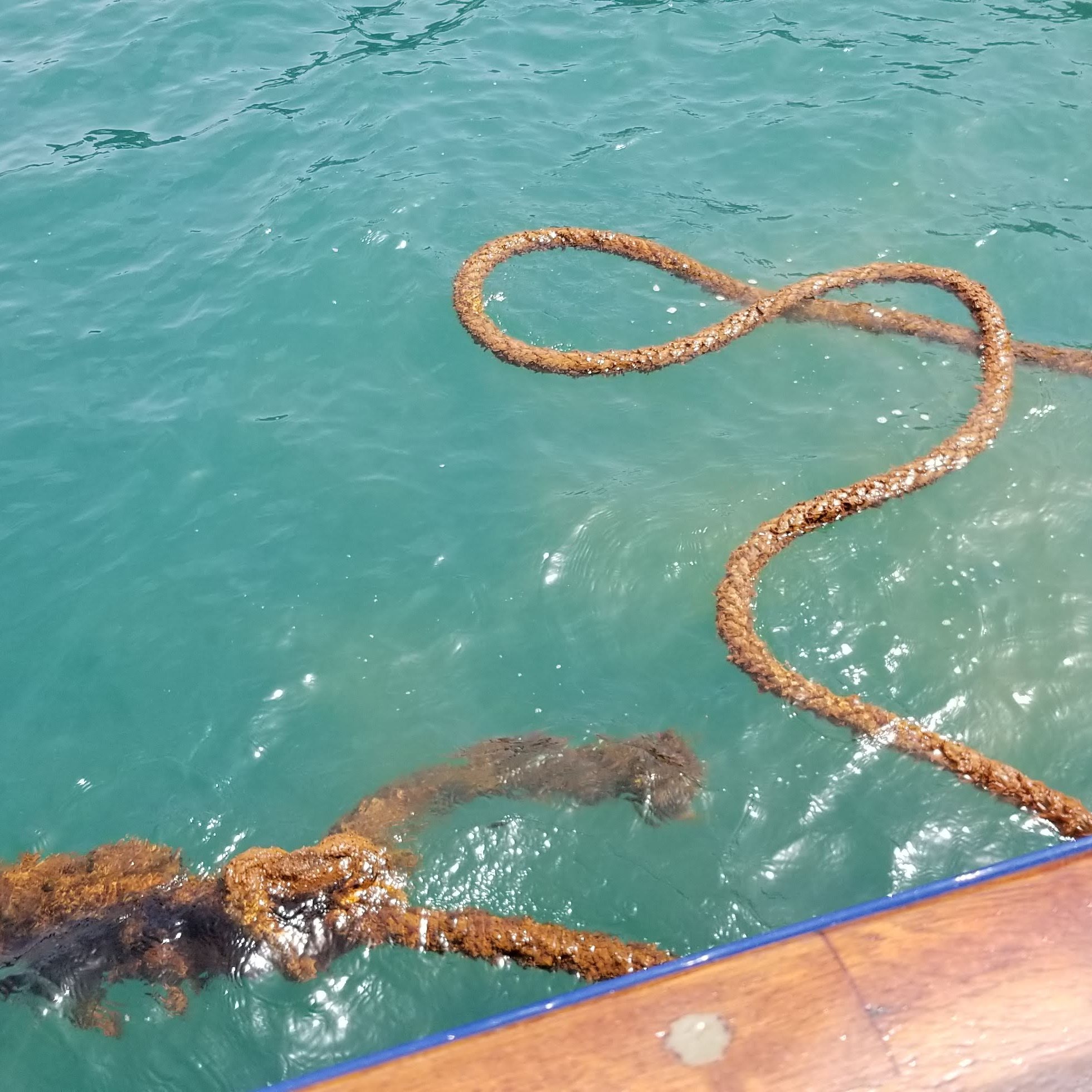The story of Atlantis has fascinated me since I was a child. The idea of a city that sank into the ocean in one day, never to be seen again, has intrigued the world for centuries. It’s the allure of the mystery, the mythos of the gods, the theories of a race of people living below the sea. Even Disney made a film about the lost city of Atlantis, and like Milo Thatch, I wanted to find this city. Unfortunately, I don’t have a super wealthy sponsor with all the means in the world to supply me with an underwater vehicle and a whole crew of adventurers, but I did have an enthusiastic tour guide, a little museum with a 9D theatre, and an ancient island to explore.
Santorini, Greece is iconic for the blue domes of Oia, the beautiful sunsets, and the sea that is impossible shades of blue and turquoise. But it’s also a city with a long and captivating history. As the sight of one of the largest volcanic eruptions in human history, the once thriving ancient civilization was wiped out in one night. A large portion of the circular island sank into the ocean, leaving the familiar crescent shape we see today.

Visiting Santorini was a dream. The island is beautiful, the people are friendly, and the food is delicious. We had four full days to explore the island and there’s still so much to see. I could go on about every beautiful thing I saw in Santorini, but we’re here to find Atlantis.
The first stop in our search brings us to the ruins of Akrotiri. The archeological site uncovered here reveals a prosperous advanced civilization that one can’t help but wonder is the fabled lost city of Atlantis. As you tour the ruins, you enter a covered building with walkways surrounding the ancient city. It’s incredible to see such an old place in such remarkable condition. Often times, you have to rely on artist’s renditions or reconstruction, but the homes and streets of Akrotiri are still here. The volcanic ash that buried the city preserved this long-forgotten place so that thousands of years later, we can glimpse its history. As someone who loves to visit ruins, Akrotiri was far beyond any ancient place I’ve visited before.

But how is this city Atlantis?
According to the Plato, the city of Atlantis was an advanced civilization. Today, advanced means technological feats only seen in science fiction and the imagination. In the 17th century B.C., it meant toilets.
One of the most distinct features of this civilization is the drainage system that wouldn’t reappear in human history until later. They had two- and three-story houses, elaborate frescoes, and even rooftops designed to withstand earthquakes. Things we barely bat an eye at today, but in the time of this civilization, the advancements here were unseen anywhere else in the world at the time.

And it all vanished in a matter of days. The series of earthquakes may have given the people time to evacuate, but the subsequent eruption that sank much of the island was felt far beyond the island. The resulting tidal wave reached all the way to Crete, wiping out the Minoan civilization there as well.
And you can visit the site of the ancient volcano today.
The next stop in our search for Atlantis takes us out to the remarkably blue waters of the Aegean Sea. In the Fira Old Port waits several vessels brimming with tourists. These ships embark every day to the small islands that make up the entire complex of Thira, including the still active volcanic island, Nea Kameni.
Nea Kameni, or New Burnt Island, is the first stop on the boat tour. After docking in the vivid waters, you enter an island reminiscent of Jurassic Park. During your climb to the top of the island, you pass five craters as your guide shares the history of the Thira caldera. As you walk the island, you can smell the sulfur rising from the volcano and feel the heat from the smoldering lava far below the surface. Unfortunately, if you’re like me and have a strange fascination with lava, the only evidence you’ll see are the black igneous rocks that have cooled as the lava built up the island.
The trek is not for the faint. Most of the journey is uphill in the sun. Luckily, we had good weather, though I imagine summertime makes the walk unbearable. But if you manage to make it all the way to the 130-meter peak, you’ll be rewarded with a spectacular view of Thira. Here, your guide will tell you the story of Atlantis.

Our guide was a wonderful storyteller. You could feel the passion in his voice for the island of Santorini and the trek he makes to the top of Nea Kameni he’s made hundreds of times. From here, you see the full extent of Thira and can imagine what it was in ancient times. You see the major island of Santorini and its crescent shape, smaller Thirasia, and the tiny Aspronisi. The rest of the once circular island sank long ago in the major eruption.
After taking in the expanse of the caldera, the next stop brings you to the thermal waters of Palia Kameni, or Old Burnt Island. Like Nea Kameni, this smaller island was but up by volcanic activity, though the island is no longer active. As someone who is terrified of swimming anywhere with fish in the vicinity, I didn’t personally dive in, but I still admired the water. The shades of the Aegean Sea seem unreal, almost like a filter was put over this part of the world. You also contemplate what lies below the surface, waiting to be discovered. What secrets that could lead us to the lost city of Atlantis? For now, that mystery remains buried in the sea.



Here is where the three-hour boat tour ends, but I can’t recommend the six-hour tour enough. After the thermal waters you spend lunch time on the small island of Thirasia. Known as a mini-Santorini, the island is quiet and peaceful. We ate at a restaurant overlooking the waters and we simply couldn’t get enough of the view. I can see why so many people have called Santorini their home over the millennia.
After lunch, the tour goes by the famous city of Oia, the newest addition to Santorini’s long history. Once you return to Fira, you can continue your exploration of the ancient civilization that once thrived on the island by visiting the Museum of Prehistoric Thera. Many treasures recovered in Akrotiri are housed here, including the ornate frescoes, pottery, and artifacts.
Unfortunately, I didn’t have the opportunity to explore the museum, or the archeological site of Ancient Thera in Kameni. Off season transport in Santorini is doable, but tricky. Most bus stops have barely a mark on the road and if you didn’t snap a picture of the timetable at Fira Station, you might be waiting a while. In the more rural parts of Santorini, it’s really a game of chance and estimating the time it takes for a bus to leave one station. Once you figure it out, it’s easy to get around, but you can’t always rely on a sidewalk so the walk can be daunting at times. Car rental is easy and affordable if you don’t trust yourself with buses, and taxis are available but pricey.
One of the pieces of evidence in the claim that Santorini is the lost city of Atlantis are the multi-colored beaches around the island. According to Plato, Atlantis was built with red, black, and white stones. And Santorini happens to have a red beach, a black beach, and a white beach. One could imagine ancient people of the island used these colored stones to build their cities that Plato would speak of many centuries later.
The red beach sits near the ruins of Akrotiri, the deep red stones contrasted stunningly against the blue waters. Several beaches boast the black sands created from Santorini’s volcanic history, including Perissa, Perivolos, and Kamari Beach. The white sands beach is near Akrotiri as well, but the secluded beach is only accessible by foot. These distinct features or the island give more credit to the theory of Santorini being the location of Atlantis. Such a vivid detail lends itself to the mounting evidence.

The final stop in our hunt for Atlantis brings us to one of the most unique experiences I’ve ever encountered: the Lost Atlantis Experience Museum in Megalochori. The small museum opened in 2019 and managed to weather the Covid-19 pandemic, which I’m so grateful for. The museum provides one-of-a-kind experiences, including a hologram of Plato, allowing visitors to ask the great philosopher all the questions they have regarding Atlantis. Guides show you through the museum and help you navigate the floor covered in lava and show you the detailed floor layout to experience the story of Atlantis from start to finish.
The 9D theatre immerses you completely in the final moments of the ancient civilization in Akrotiri. Be sure to strap in tight because you will feel the ground quaking, get sprayed with water, and feel the winds around you. It’s only a fraction of the true terror of that fateful day, but it’s still quite the thrill.
Following your cinematic adventure, you can hold the trident of Poseidon, the patron god of Atlantis, get a full view of the diorama of Plato’s depiction of the city, and learn the history of the mythical city as described by Plato and how it’s linked to Santorini. It’s impossible to leave the museum without at least a tiny bit of belief in the theory. The museum is worth the visit, no matter what brings you to Santorini.
The island itself is brimming with history and life and you can feel the love that people have for their home and its possible connections to the lost city. From the enthusiastic tour guide whose passion is evoked in every word, to the quaint Atlantis Bookshop that once opened its doors to visitors in Oia, to the museums dedicated to keeping the history of Santorini alive, you know that whether or not it was the site of Atlantis, Santorini has magic found in every corner of the island.

So, is Santorini the lost city of Atlantis? We will never truly know. Human history is rife with legends and tales that appeal to audiences several millennia later. These stories survive because we continue to tell them and keep them alive. Stories like the great King Arthur, Robin Hood, and the sinking of Atlantis all have some historical merit. We can prove a great Saxon king lived in Britain, that a band of men stole from the rich of Nottingham to give to the poor, and that this once prosperous city vanished in a cataclysmic event. But humans are story tellers. We embellish every tale, making it grand and captivating, with a lesson in there to pass to the next generation. The death of King Arthur and his body returned to the mythical island of Avalon is a story of hope that a great king will one day return to save Britain. The deeds of Robin Hood demonstrate an ideal world where the greed of the rich is punished, and wealth is given to the poor. The sinking of Atlantis was a warning to the Greeks against their own hubris, lest the gods destroy them.
Atlantis is a story, a myth that will continue to captivate people. Santorini makes a compelling case to be the lost city, but perhaps the truth will forever be lost to history. That doesn’t mean we can’t continue to search. For now, I will continue to dream and cherish my days in Santorini, among a lost civilization that once called the beautiful island their home.


